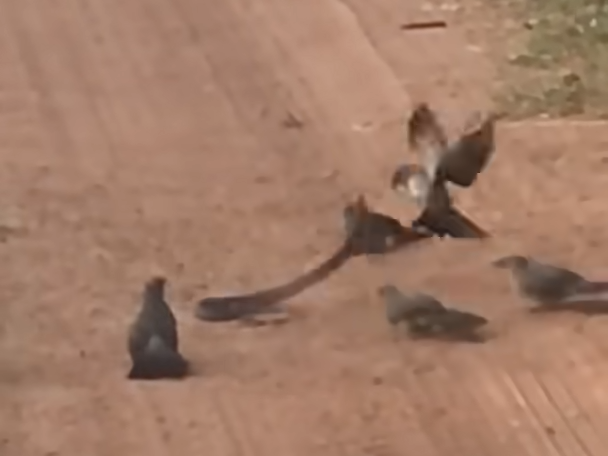Watch the sighting here:

Keith Raine recorded the event and submitted his account to Latest Sightings. He and his wife watched the interaction while visiting Dinokeng Game Reserve, north of Pretoria.
Interesting sighting
Keith said, “During a camping weekend, we came across this group of arrow-marked babblers and a glossy starling attacking a juvenile boomslang. It was very interesting to watch!”

At the beginning of the video, we see a snake surrounded by a party of 11 birds. According to Keith, the group consists of 10 arrow-marked babblers and one glossy starling.
Boomslang
As mentioned, the snake is a boomslang; either a juvenile or female, given its drab colouration. The word ‘boomslang’ means tree snake in Afrikaans.
As a result, they typically stay in trees, preying on rodents, reptiles and eggs.
Bird species
Arrow-marked babblers (the brown birds) are highly sociable, living in stable groups. They are easily identified by their “gra-gra-gra-gra-gra” contact calls and numerous chevron-like markings.
Glossy starlings occur in pairs or small flocks. They have a distinctive dark blue-green, glossy plumage.
Mob behaviour
As shown in the video, the birds are not happy with the presence of the snake. As is typical when this happens, the birds will draw attention to the presence of their enemy by calling out in alarm.

Outnumbering their foe, they will then collectively harass it in an attempt to either drive it away or kill it.
As we see, surrounded by so many adversaries, it is difficult for the snake to defend itself as they take chances attacking.

Fearless but cautious
The birds encircle the snake but keep a near-constant distance from it. Somehow, they can estimate the snake’s striking range and stay beyond its reach.

Highly venomous
Boomslang venom is haemotoxic, meaning that it destroys red blood cells, leading to internal bleeding. Should any of the birds get bitten, it would be dead in minutes.
Targeted attacks
As the birds attack, it is obvious that, despite the risk of being bitten, they are targeting the snake’s head.

At times they attack individually, while at others they simultaneously assault the stricken serpent.

Getting weaker
Suffering a near-constant aerial bombardment, the snake gets progressively weaker. Writhing on the ground, it is at their mercy.

Seeing their foe debilitated, the birds are further emboldened. At times, they physically pick up the snake before dropping it again.

Savage starling
Of all the birds, the starling seems the most determined to harm the snake. Time and again, it strikes the snake with savage effect.

As we soon see, there is a very sinister reason the birds are prepared to risk everything by attacking the head.
Escape?
Get our Best Sightings as they Come in
Eventually, the snake made it into the grass by the roadside at which point the birds left it alone. While they could have continued their attack, Keith explains a possible reason they stopped,
“The snake made it to the grass where the birds backed off. As we drove past the snake it had lost both its eyes, so it didn’t look too hopeful.”
Natural balance
In Nature, it often looks like the predator enjoys an advantage. As seen in this video, that is not always the case.
Prey species may evolve cooperative social behaviours, like mobbing, to even the odds. Other tactics are mimicry, camouflage, smelly secretions and venom of their own.
Understanding this interplay makes observing Nature infinitely more enjoyable. And unpredictable.
